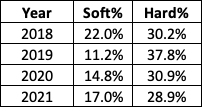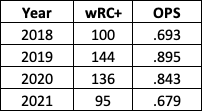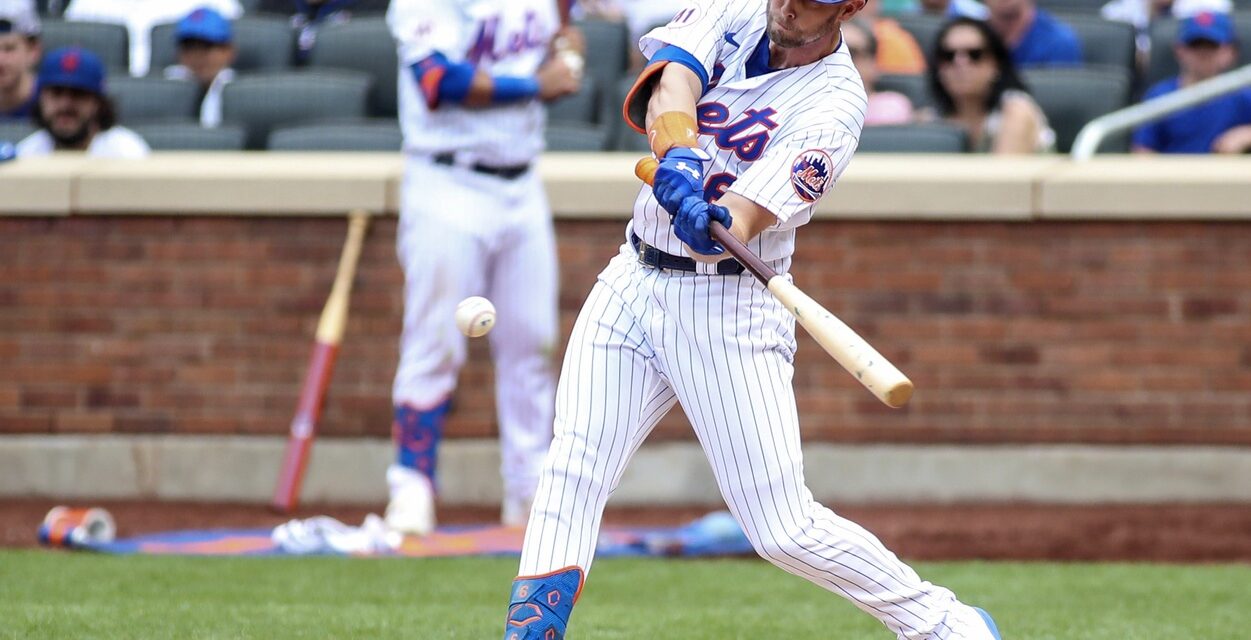
Mandatory Credit: Wendell Cruz-USA TODAY Sports
The 2021 season didn’t go how the New York Mets hoped, and there were a number of players on the roster who emphatically agreed with that statement. One of those players was likely infielder/outfielder Jeff McNeil, who put together the worst offensive performance of his young MLB career.
Between his MLB debut (July 24th, 2018) and 2020, the left-handed hit machine slashed .319/.383/.501 with 30 home runs, 117 RBI, and 137 runs scored through 1,204 plate appearances. During this period, McNeil’s 140 wRC+ was among baseball’s 15 best hitters, while his 8.6 fWAR ranked just outside the top 20. By now, we all know the unfortunate step back his production took last season — in 426 plate appearances, he hit .251/.319/.360 with seven homers, 35 RBI, and 48 runs scored, which led to a 93 wRC+ and 0.5 fWAR.
Other projections will eventually get released prior to the season, but Steamer and ZiPS are each expecting a rebound from McNeil in 2022. Steamer pegs him for a .278/.344/.425 line, good for a 114 wRC+ and 1.5 fWAR. Meanwhile, ZiPS has a more optimistic view, which includes a .282/.346/.426 line, a 111 OPS+, and 2.9 fWAR.
With this potential bounce-back in mind, McNeil will obviously have to elevate his performance in a number of areas. The following three trends must stop going in the wrong direction if he wants to get back on track.
Quality of Contact
With a career walk rate of 6.8% and a career strikeout rate of 12.5%, McNeil creates plenty of opportunities to put the ball in play while in the batter’s box. With all those opportunities, though, he hasn’t been able to maintain the career-best soft-hit rate and hard-hit rate numbers he produced during his first full season of 2019. Here’s a look at how his numbers in each of those categories has progressed since debuting in 2018:

That’s most certainly not what the doctor ordered, especially after a sizable jump between 2018 and 2019. McNeil could get a bit of a mulligan in 2020 since it was only a 60-game season and he caught fire over the final month. However, the trend continued this past season with the schedule back to normal.
In looking at other parts of his batted-ball profile, we can see that McNeil’s ground-ball rate has risen each season, going from 38.7% in 2018 to 46.6% in 2021. His fly-ball rate has gone on a similar trajectory, although it slightly increased this past year. That number was up at 39.7% as a rookie before settling in at 32.9% in 2021.
His performance for each of these batted-ball events took a significant dive in production, too. For ground balls, his yearly wRC+ went from a career-high 115 in 2020 to a career-low 48 in ’21. Meanwhile, his fly-ball production has taken a hit since posting a 162 wRC+ and 1.052 OPS in 2019. Those numbers have gone down to 80 and .723 in ’20, followed by 42 and .550 in ’21, respectively.
Performance vs. Four-Seamers
As with most hitters, the most frequently used pitch against McNeil since getting promoted to the big leagues has been the four-seam fastball. What’s interesting here is that his approach seems sound, but the results are the complete opposite.
The 29-year-old’s 21.6% chase rate and 86.2% swing rate on strikes are both career-best marks against this particular offering. It translated to plenty of contact, too — his 90.0% contact rate on four-seamers was also a single-season best for him. But when that contact is broken down into different batted-ball events, we can start seeing what some of the problems are.
His 24.4% line-drive rate and 41.5% ground-ball rate are both career-worst marks, along with being a stark contrast from what he did the year prior (30.2% and 34.0%, respectively). Although his 34.1% fly-ball rate wasn’t terrible compared to previous seasons, it was accompanied by a 28.6% infield-fly rate.
This led to a decrease in overall production we weren’t expecting to see from McNeil. Here’s how his wRC+ and OPS have progressed from 2018 through 2021:

Performance on the Road
Since joining the Mets in 2018, McNeil’s offensive production has been significantly better when he plays at Citi Field than when he’s a visiting player. This is the case when measuring by his wRC+ (146 at home, 106 on the road) and OPS (.876 at home, .775 on the road). The key here, though, has been that wherever the game is taking place, he’s produced like an above-average hitter.
The gap between these two situations has increasingly gotten worse over the years, with this past season being the worst of all.
Here’s a look at how McNeil’s home wRC+ and OPS have differed from his road numbers over the years:

Part of what’s made McNeil such a valuable offensive player is that he’s been rather consistent across the board. If he has an everyday spot in the lineup this upcoming season, he’ll need to find a way to not disappear in certain situations. One of the biggest issues with New York’s offense this past year was the inconsistency, and this is a perfect example of that.
We’ve seen what McNeil can do in previous years. The talent is there and it’s paired with a proven (albeit short) track record. Early projections are confident he can return to form, but he has some work to do to make it happen.
















